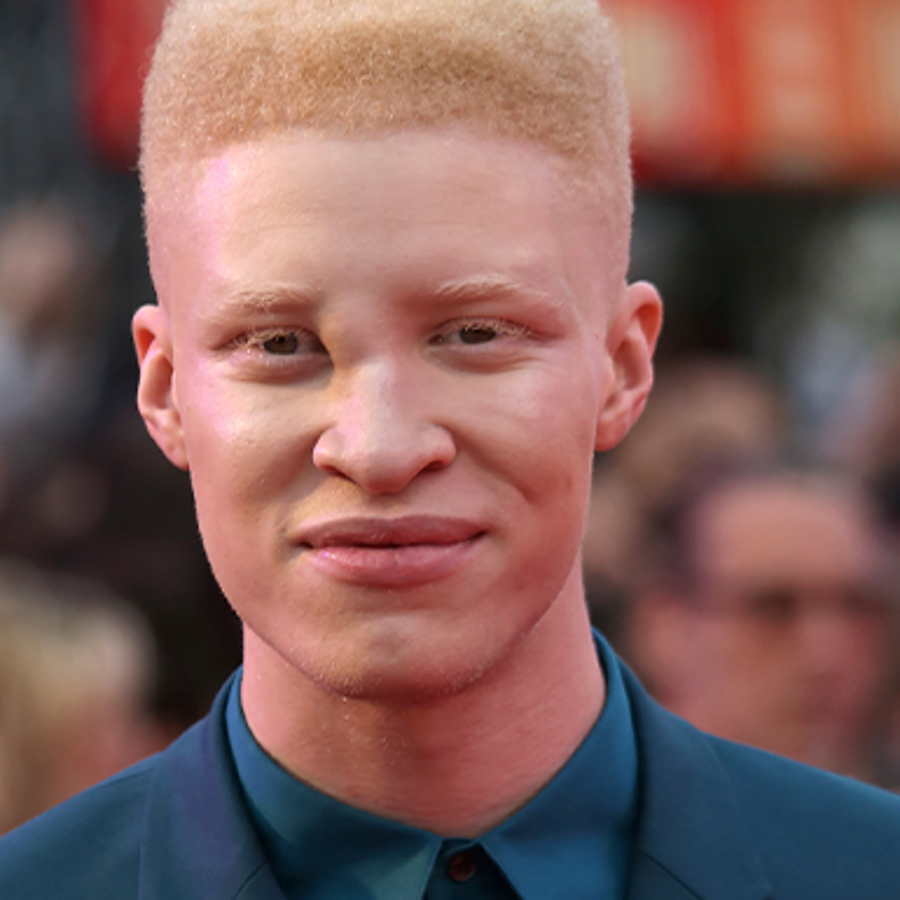
Why do some Africans with albinism have green eyes?
November 12, 2014

- Related Topics:
- Ancestry,
- Albinism,
- Pigmentation traits,
- Autosomal recessive inheritance
An undergraduate student from the Netherlands asks:
"Why do some Africans with albinism have green eyes? And why if they make no pigment are they darker than Europeans with albinism?"
When many people think “albino,” they may think of a person or animal with perfectly white skin and hair and bright red eyes.
But the reality is much more complex. For one thing, red eyes are extremely rare in people. Even individuals with the most intense form of albinism usually have blue eyes.
In this form of albinism, the pigments that lead to darker hair, eyes, and skin do not get made. No pigment means no pigmentation, which means no color.

And this isn’t the only form of albinism out there. It turns out there are many other kinds, some of which can make some pigment.
The person you’re thinking about probably has one of the milder forms of albinism. People with milder forms of albinism often have some coloring in their eyes and skin. However, they still make much less pigment than they would if they didn’t have the condition.
That’s the short answer. But there is also a long answer, of course.
Let’s delve into the long answer, and see how different genes with different roles are affected in the different types of albinism.
Albinism is Less Pigment
As I said, albinism is a genetic condition that causes cells to make less pigment. This leads to lighter skin, hair, and eye colors. It’s fairly rare.
Some types of albinism are limited to effects in the eyes, whereas some are also seen in skin and hair. If it just affects your eyes, it’s called Ocular Albinism (OA). If it also affects your skin and hair, it’s called Oculocutaneous Albinism (OCA). Let’s focus on OCA.
The main pigment that causes colors in skin, hair, and eyes is called melanin. You can think of it as a “paint” that your body uses to give it color (and protection from the sun).
Making melanin is not easy. It takes a lot of genes all working together.
Some of these genes work one after the other to build melanin up from the amino acid tyrosine. Still other genes work to create the right environment in the melanosome, the special place inside cells where melanin is made.
You can think of making melanin like making something in a factory. Say, donuts.
Some of the genes are like the assembly line; cutting, cooking, and glazing the donuts. Others provide the lights, air conditioning, power, and so on, so the conditions are right for the assembly line to work well and make lots of donuts.
The classic form of albinism, OCA1, happens when one of the genes on the assembly line is completely broken. In OCA1A, this broken tyrosinase (TYR) gene causes the whole process to stop so no pigment gets made. This is why people with OCA1A albinism have so little coloring.
Sometimes the TYR gene is mostly broken, but can still work a little. It’s as if the donut glazing machine on the assembly line is broken, but a bit of glaze still dribbles out, so you can still make some donuts. In albinism terms, this means that a small amount of pigment manages to get past the broken gene. People with this form of albinism, OCA1B, have a bit of color, but are still pretty light.

There are also other forms of albinism in which a bit of melanin gets made. This can happen when genes that affect the conditions on the factory floor are broken. In this case, the whole process doesn’t stop; it is just less efficient.
This would be like if the air conditioning in the factory breaks and the machines keep stopping because they’re overheating. You can turn them back on after they cool off, but you aren’t going to get as many donuts as you would if the air conditioning were on.
The most common type of albinism like this is called OCA2. The broken “air conditioning” here is the broken OCA2 gene, which causes problems with the acidity inside the melanosome. This makes the melanin making process slow way down, meaning less pigment in the end.
Still, people with OCA2 can make some pigment, and the amount they make can vary a lot. They can look very light, or they can look almost like they don’t have albinism at all. However, they will still look lighter than their siblings or family.
People with OCA2 can also get darker as they get older. Africans with OCA2 can actually get fairly dark skin, and they can have blue or hazel eyes. This could be the type of albinism that the person you’re talking about has.
There are also other types of albinism. In OCA3 and OCA4, other genes are affected. People with OCA3 may have reddish skin. People with OCA4 look similar to those with OCA2. In OA, only the pigment in eyes is affected, but skin looks basically normal.
Other disorders can cause OCA along with many other effects on the body. These are caused by different mutations than those described above. One example is Hermansky-Pudlak syndrome. It causes albinism as well as bleeding, bruising, and lung problems. Scientists think that there may be other types of albinism as well.
Albinism is Rare
People from all over the world can have albinism. Overall, about 1 in 17,000 people have one type or another.
About 1 in 40,000 people have OCA1. However, people of African descent are less likely to have this form.
OCA2 is the most common type of albinism. Overall, about 1 in 36,000 Americans have OCA2. It’s much more prevalent in African Americans: about 1 in 10,000. In some parts of Africa it can be as high as 1 in 3,900 people.
The Person You Describe Probably has OCA2
The person you’re describing is African, has green eyes, and is darker than Europeans with albinism. Since this person produces some pigment, he or she probably doesn’t have OCA1A.
They most likely have OCA2, which can cause exactly what you described, and is the most common. They could have OCA1B, but it’s a lot less likely, because it is much less common in people of African descent.
Although we do know a lot about albinism, it is still being studied today, and we have more to learn. For instance, scientists are still discovering more ways about how our genes affect skin pigmentation in general.
Read More:
- Albinism.org: More on the different types of albinism
- National organization for albinism and hypopigmentation: What is albinism?
- What can happen with too many doughnuts

Author: Liz Freeman
When this answer was published in 2014, Liz was a Ph.D. candidate in the Department of Biology, studying carbon acquisition in algal photosynthesis in Martin Jonikas’s laboratory. She wrote this answer while participating in the Stanford at The Tech program.
 Skip Navigation
Skip Navigation
